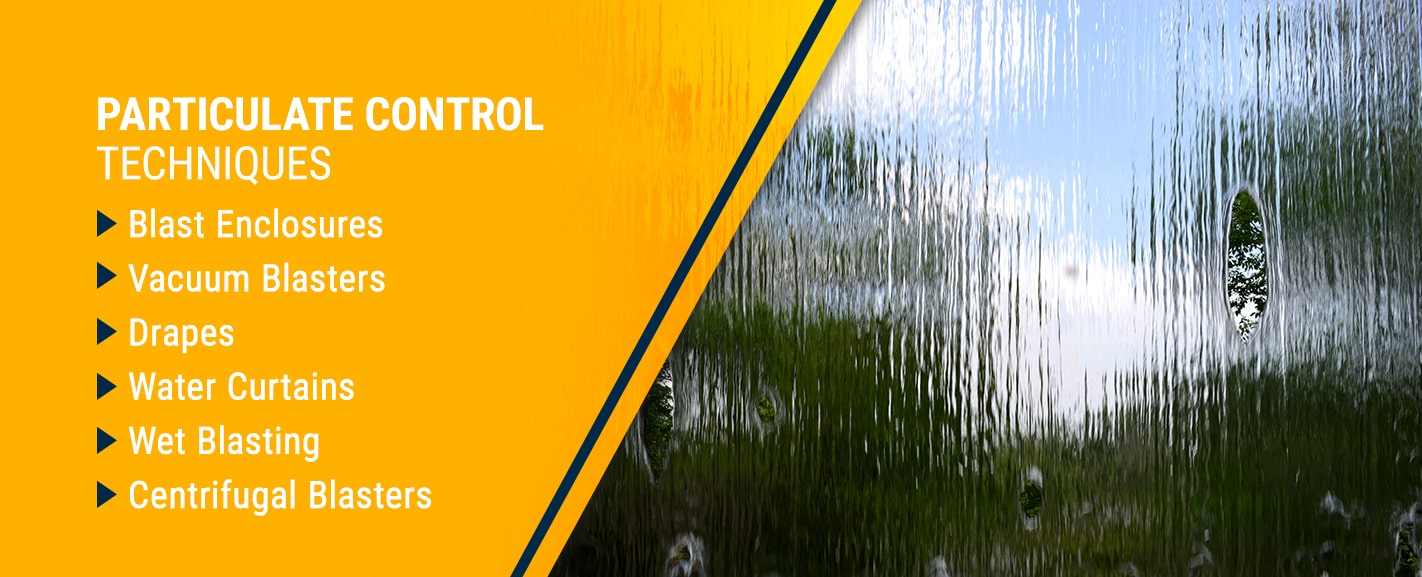Abrasive blasting, also known as sandblasting, is a cleaning or preparation process that entails forcibly shooting a stream of abrasive material against a surface. These abrasive materials can come in the form of glass beads, aluminum oxide, plastics, silicon carbide, sand and many other fine materials. When broken down during the blasting process, these fine materials create dust particles that can be harmful not only to the human body but also to the environment.
Luckily, environmental controls, abrasive blasting regulations and particle control techniques are in place to control the spread of these particle emissions into the air, which causes harm to the environment.
Is sandblasting bad for the environment? When the abrasive materials come into contact with the surface material, the abrasive materials break up into extremely small pieces of dust. These particle emissions are a significant source of air pollution, so there can be a harmful relationship between abrasive blasting and the environment.
The particle emissions often carry varying amounts of silica, aluminum, arsenic, copper and other harmful substances, depending on blast factors like the type of equipment used, the velocity of the blast, the blast angle, the distance from the part being blasted, part dimensions and the dust control operations in place before the blasting process.
When these tiny emissions dust particles pollute the air, the effects on the environment can be devastating. Research has shown that these emissions can be so impactful to the environment that they can even change weather patterns, cause periods of drought, cause climate change and even cause the oceans to acidify. Particle emissions released into the air contribute to the greenhouse effect, which traps heat in the atmosphere, restricting it from leaving the planet.
Luckily, there are several abrasive blasting best practices to help reduce these particle emissions and their negative effects on the planet.

With the great risks to the environment that come along with abrasive blasting, strong environmental regulations and dust control techniques are critically important to ensure the retention and recovery of the emissions released during blasting. Some of these techniques include blast enclosures, vacuum blasters, drapes, water curtains, wet blasting and centrifugal blasters.
Blast enclosures aim to completely enclose the abrasive blast operations in a box-like structure so that the particle emissions cannot make their way into the air. In many blast enclosure designs, ventilation systems are in place to remove the dust from the air before the product being blasted is removed from the enclosure.
Blast enclosures are, for the most part, very effective in containing and recovering the particle emissions produced by abrasive blasting, with only small amounts of debris getting released at the blast enclosure joints. Blast enclosures may be relatively pricey and tend to slow down the overall cleaning process.
Vacuum blasters work similarly to a vacuum that you would use to clean the floors and carpet of your house. As paints and other surface coatings are being removed during the abrasive blasting process, the vacuum blaster simultaneously sucks in any emissions that are being released into the air. These emissions are stored in a capture and collection system that surrounds the blast nozzle. The abrasives collected in the collection system are then available for reuse in the blasting process.
While this process is great for particle emission collection, similar to the blast enclosures, they tend to be rather expensive and may be hard to find. In addition, vacuum blaster units are sometimes clunky, heavy and somewhat difficult to use.
Drapes, also referred to as curtains, are another important form of particulate control that help prevent harm to humans and the surrounding environment. Drapes are porous and placed on both sides of a truss-type structure with the goal of diverting debris downward into a lined net under the blasting operations to collect any debris released during the blasting process.
Drapes aren’t always the most effective method of particle control. In some cases, dust can spill through the drapes, and additional dust spillage often occurs due to wind or any drafts around the blast zone. However, drapes are typically one of the cheaper control techniques and still provide critical protection to the workers and the environment.
The control technique of using water curtains involves installing a series of nozzles along the edge of the structure or surface being blasted. The spray from these nozzles shoots downwards, creating a water curtain that redirects and collects the debris from the blasting process.
This debris in the water is then sent downward to the ground, where it collects in water troughs. After that, the mixture of and abrasive material can go to its appropriate container for disposal.
The particle collection technique of water curtains is relatively cost-effective and offers an excellent way of reducing harmful particle emissions during the blasting process.
Wet blasting can come in several different types, such as wet abrasive blasting, high-pressure water blasting, high-pressure water and abrasive blasting and air and water abrasive blasting.
This control technique works by adding water to the abrasive blasting nozzle to mix the water and abrasive particles. This mixture captures the dust emissions immediately on impact, preventing any from harming workers or the environment.
While wet blasting is effective in collecting dust emissions, the water used during the blasting process may reduce the rate of surface cleaning achieved with dry blasting. To fix this problem, you can place a retrofit device over the end of the blast nozzle.
Centrifugal blasters use a high-speed blade that propels abrasives against the surface of whatever is being cleaned. They then recycle the abrasive with the help of a collection system that lets very little debris escape.
These blasters are typically used on large, flat and horizontal structures such as ship decks, but there have also been efforts to develop a smaller, hand-held version for more versatile use. These smaller, hand-held centrifugal blasters will be ideal for use on bridges and other similar structures.

With the amount of damage to the environment that can come along with the particle emissions released from abrasive blasting, it is critical to implement the abrasive blasting pollution preventative practices listed above to help keep the earth green.
Have any additional questions about particle control techniques or abrasive blasting in general? Reach out to Finishing Systems, a top provider of finishing solutions and products to large and small companies across the country for the last 40 years. Get your questions answered today.